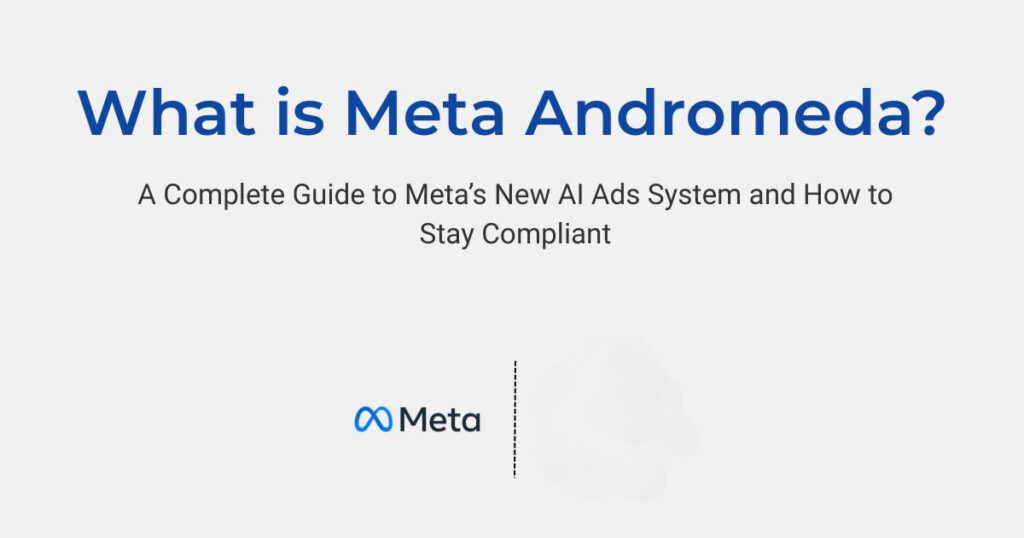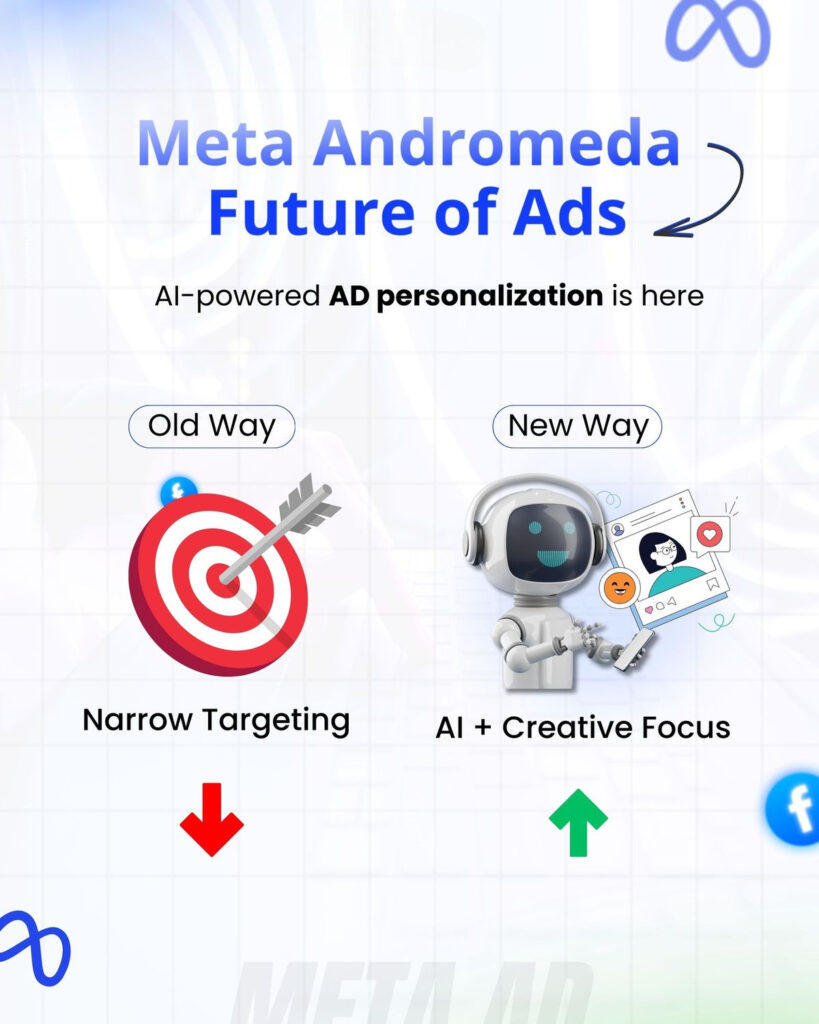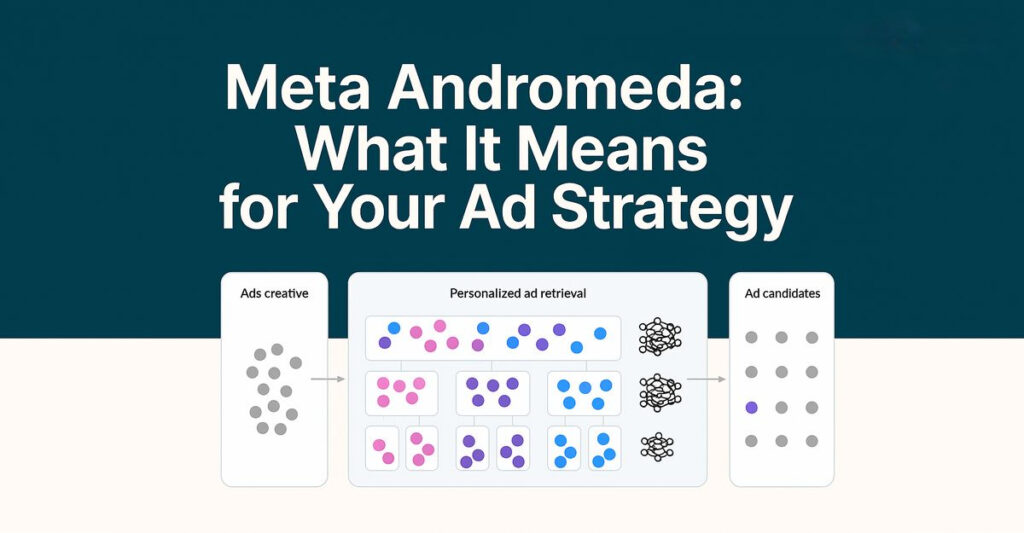Introduction
Meta’s latest Andromeda update is shaking things up in the advertising landscape. For years, advertisers on Facebook and Instagram have leaned on structured campaign setups, precise targeting, and a gradual optimization process to see results. But with Andromeda, Meta is taking a bold step forward with a more sophisticated retrieval and matching system that transforms how ads are served to users.
This update highlights the importance of creative variety, automation, and broader targeting, prompting marketers to rethink their strategies. In this blog, we’ll dive into what Andromeda is all about, why it’s significant, and how you can adapt your approach to maximize your Meta advertising efforts in 2025 and beyond.

What Is Meta Andromeda?
Andromeda is Meta’s innovative retrieval engine—the technology that determines which ads are shown to which users at any given moment. Rather than simply delivering the highest-performing ad to the largest audience, this system now focuses on creative diversity and matching ads to users.
This means that Meta isn’t just selecting “the best ad” to show everyone; instead, it aims to pair different ads with different individuals based on their behavior, context, and likelihood of engagement. The outcome is a more dynamic ad delivery process that benefits advertisers who provide the algorithm with a rich variety of creative options.
Why Did Meta Launch Andromeda?
The digital advertising landscape has evolved. Users expect personalized content, and competition is higher than ever. Meta designed Andromeda to:
- Improve the relevance of ads by matching specific creatives with specific audience segments.
- Encourage advertisers to use multiple ad variations rather than relying on a single “winning” ad.
- Reduce over-segmentation in campaigns, which often limited Meta’s ability to optimize effectively.
Align with the trend toward automation and machine learning in digital marketing.
How Andromeda Changes Ad Campaigns

1. Greater Importance of Creative Diversity
Under Andromeda, running one or two variations of an ad is no longer enough. The system thrives on multiple creative inputs—different hooks, visuals, messages, and formats. Marketers need to think in terms of variety: video, carousel, static images, storytelling ads, testimonials, and problem-solution formats.
2. Simplified Targeting
Previously, advertisers would create multiple ad sets, each targeting specific narrow interests or demographics. With Andromeda, broad targeting performs better because the algorithm has more flexibility to optimize delivery. This doesn’t mean ignoring audience research, but rather giving Meta room to test and match ads to users more effectively.
3. More Frequent Creative Refreshes
Because the system tests and rotates more variations, creatives can fatigue faster. To stay competitive, marketers should refresh ads regularlyadding new options every week or two. Brands that supply fresh material consistently will keep Andromeda working in their favor.
4. Advantage+ Campaigns Gain More Power
Meta’s Advantage+ campaigns (automated setups that handle placements, targeting, and creative optimization) align closely with Andromeda. They allow advertisers to upload a wide range of assets and let Meta’s system choose how best to serve them. This reinforces the shift toward automation and away from micromanaging ad sets.
Best Practices to Succeed After the Update
Invest in Creative Production
Plan campaigns with at least 10–20 creative variations. Different angles—such as testimonials, founder stories, product benefits, or emotional appeals—help the algorithm find what resonates with different users.
Mix Formats and Styles
Combine short-form videos, long-form videos, carousels, single images, and UGC-style ads. A balanced mix increases the likelihood that Meta will match your creative with the right audience.
Broaden Your Targeting
Instead of running many small ad sets, consolidate audiences into larger groups. Let Andromeda optimize delivery within those groups, rather than restricting it.
Refresh Regularly
Update your ads often to prevent fatigue. Even small changes—such as new headlines, colors, or CTAs—can extend the life of a creative.
Focus on Tracking and Data Accuracy
Ensure your conversion tracking is properly set up. Andromeda relies on feedback loops, so inaccurate event tracking (e.g., purchases, leads, sign-ups) will reduce performance.
Monitor Key Metrics
Keep a close eye on creative fatigue, frequency, cost per result, and ROAS. Use these metrics to decide when to replace or duplicate high-performing ads.
Meta Andromeda Strategies

Leverage Creative Diversity
- Use multiple ad creatives (images, videos, carousels) so Meta’s AI can test and optimize.
Adopt Broad Targeting
- Let Meta’s delivery system find the best audiences using machine learning rather than restricting too much.
Utilize Automation Tools (Advantage+ and More)
- Test Advantage+ campaigns for scaling and better budget distribution.
Refresh Ads Regularly
- Rotate creatives frequently to prevent ad fatigue and maintain performance.
Focus on First-Party Data
- Use custom audiences, pixel data, and conversions API to help Meta’s AI optimize delivery better.
Balance Prospecting and Retargeting
- Don’t over-rely on retargeting; give Meta’s system enough room for prospecting.
Optimize for Conversions, Not Just Clicks
- Choose the right objective (purchases, leads) to align with Meta Andromeda’s delivery focus.
Test Campaign Structures
- Experiment with CBO (Campaign Budget Optimization) vs. ABO (Ad Set Budget Optimization) to see what works best.
What This Means for Marketers in 2025
The Andromeda update represents a fundamental shift: success on Meta platforms is less about micro-managing targeting and more about supplying strong, diverse creatives that the system can match with users.
Marketers who adapt quickly by focusing on creative variety, automation, and smart optimization will see stronger results. Those who cling to old methods—like narrow targeting and limited creatives—may struggle as the platform evolves.
Conclusion
Meta’s Andromeda update is not just another algorithm tweak—it’s a major transformation in how ads are delivered and optimized. By embracing creative diversity, broader targeting, automation tools like Advantage+, regular ad refreshes, and keeping all strategies in the same cart advertisers can stay ahead of the curve.